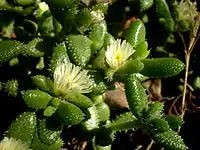Delosperma
Delosperma ('delos'=evident, 'sperma'=seed) is a genus of around 170 species of succulent plants, formerly included in Mesembryanthemum in the family Aizoaceae. It was defined by English botanist N. E. Brown in 1925.[1] The genus is common in southern and eastern Africa, with a few species in Madagascar, Reunion island, Yemen and Saudi Arabia.[2][3] Delosperma species, as do most Aizoaceae, have hygrochastic capsules, opening and closing as they wet and dry.[4]

| Delosperma | |
|---|---|
_Delosperma_cooperi_-_Flower.jpg.webp) | |
| Delosperma cooperi | |
| Scientific classification | |
| Kingdom: | Plantae |
| Clade: | Tracheophytes |
| Clade: | Angiosperms |
| Clade: | Eudicots |
| Order: | Caryophyllales |
| Family: | Aizoaceae |
| Subfamily: | Ruschioideae |
| Tribe: | Ruschieae |
| Genus: | Delosperma N.E.Br. |
 | |
range of the genus | |
Distinguishing characters
Plants of the genus Delosperma can be distinguished by their seed capsules. When these open (in response to rain), the seeds are exposed and not covered by a protective membrane, like those of most other plants in the family. The membrane is sometimes reduced to just a ledge (a feature shared by the related genus Trichodiadema. The triangular valves, which open outwards when wet, each have distinctive wings on either side.
Delosperma leaves tend to grooved or covered in bladder cells, which are sometimes even extended into hairs. The leaf shape is cylindrical or sometimes flattened.[5]
 When the valves of their seed capsules open, the seeds of Delosperma are exposed, and not covered by any membrane or covering.
When the valves of their seed capsules open, the seeds of Delosperma are exposed, and not covered by any membrane or covering. Delosperma floribundum leaves showing bladder cells typical of this genus
Delosperma floribundum leaves showing bladder cells typical of this genus The bladder cells of Delosperma sutherlandii are elongated into fine hairs
The bladder cells of Delosperma sutherlandii are elongated into fine hairs The bladder cells of Delosperma pruinosum are extended into thicker hairs.
The bladder cells of Delosperma pruinosum are extended into thicker hairs.
Delosperma species are long-lived, and flower mostly in the summer. Their flowers vary greatly in colour.
Species
Species include:


- Delosperma acuminatum[6]
- Delosperma alpina
- Delosperma basuticum
- Delosperma bosseranum, iceplant[7]
- Delosperma cooperi[6]
- Delosperma congestum
- Delosperma dyeri
- Delosperma echinatum
- Delosperma ecklonis[6]
- Delosperma esterhuyseniae[6]
- Delosperma floribunda
- Delosperma hallii[6]
- Delosperma harazianum[6]
- Delosperma hirtum[6]
- Delosperma hallii aff. litorale St. Fancis Bay[6]
- Delosperma lavisiae – AGM
- Delosperma lehmannii[8]
- Delosperma lineare L.Bolus — South Africa (Free State, KwaZulu-Natal), Lesotho
- Delosperma lydenburgense[6]
- Delosperma nakurense[9]
- Delosperma napiforme
- Delosperma nubigenum[6]
- Delosperma pageanum[6]
- Delosperma pergamentaceum[6]
- Delosperma sphalmanthoides
- Delosperma sutherlandii
- Delosperma tradescantiodes[6]
References
- Taylor, Nigel; Eggli, Urs (1986). "The Lectotype of Delosperma N. E. Brown (Aizoaceae)". Taxon. 35 (4): 709–711. doi:10.2307/1221621. JSTOR 1221621.
- Smith, G.F. (1998). Mesembs of the world. Briza Publications. p. 292.
- Hartmann, Heidrun E. K. (2017). Aizoaceae - Second Edition. Springer. p. 395.
- Harrington MJ, Razghandi K, Ditsch F, Guiducci L, Rueggeberg M, Dunlop JW, Fratzl P, Neinhuis C, Burgert I (2011). "Origami-like unfolding of hydro-actuated ice plant seed capsules". Nat. Commun. 2: 337. Bibcode:2011NatCo...2..337H. doi:10.1038/ncomms1336. PMID 21654637.
- Delosperma - SANBI
- Trout's Notes on Delosperma
- "Delosperma bosseranum - Entheopedia.Org: The Encyclopedia of Entheogenic Plants". entheopedia.org.
- "The Succulent Garden :: Online nursery specialising in Succulent Plants". www.thesucculentgarden.com.au.
- Bussmann, R. W., et al. (2006). Plant use of the Maasai of Sekenani Valley, Maasai Mara, Kenya. J Ethnobiol Ethnomed 2 22.